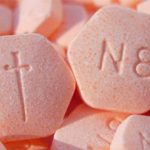- Half-Life Of Suboxone
- Suboxone Drug Tests & Detection Times
- Urine Tests
- Saliva Tests
- Blood Tests
- Hair Tests
Suboxone stays in your system for about 6-8 days. The long half-life of buprenorphine, a main ingredient of Suboxone, contributes to its slow metabolic rate.
Drug tests can detect Suboxone use for a longer length of time after the last dose. Common testing methods can detect Suboxone for 14 days after the last use, while some tests have a detection window of over 90 days.
Suboxone can block the effects of opioid drugs, reduce opioid withdrawal symptoms, and manage cravings. It is often given as a part of opioid addiction treatment programs. Its two main ingredients, buprenorphine and naloxone, are opioid agonists that bind to the same receptors as opioid drugs.
Half-Life Of Suboxone
Suboxone’s two main ingredients, naloxone and buprenorphine, have different half-life values.
The elimination half-life is the amount of time it takes for a substance to decrease to half of its maximum concentration. After five half-life cycles, substances are almost completely eliminated from the body.
The half-life of naloxone is around 90 minutes. The half-life of buprenorphine during sublingual use is between 28 to 37 hours.
After about 7.5 hours, naloxone will be eliminated from the body, while buprenorphine will be eliminated from the body after 6-8 days. Elimination times may vary based on the frequency of use, opioid tolerance, and the dose of suboxone taken.
Suboxone Drug Tests & Detection Times
Suboxone can be detected through various drug testing methods. These drug screenings can also look for metabolites, or structures that appear in the body that are unique to naloxone and buprenorphine.
Healthcare providers may test for Suboxone to ensure you are following your medication-assisted treatment schedule. Medication-assisted treatment is a crucial part of many detox and opioid withdrawal treatment programs.
Urine Tests
Urine tests can detect naloxone for up to 4 days after the last use, and buprenorphine for up to 14 days after the last use.
Urine tests have a fairly long detection window because metabolites tend to collect in urine before excretion. Urine tests are also convenient and inexpensive, making them a popular type of drug test.
Saliva Tests
Saliva tests can detect Suboxone and its metabolites for up to one week after the last use.
Saliva tests can involve a mouth swab or a direct saliva sample. Like urine tests, saliva tests are non-invasive, though their detection windows tend to be slightly shorter.
Blood Tests
Blood tests can detect Suboxone and its metabolites for up to 8 days after the last use.
Blood tests are less common than saliva and urine tests, as they are more invasive. Blood tests may be performed during medical emergencies in patients showing signs of drug overdose.
Hair Tests
Hair follicle tests can detect Suboxone for up to 90 days after the last use. Naloxone and buprenorphine can reach hair follicles through the bloodstream, where they stay as the hair grows out.
Opioid Use Disorder Treatment
Opioids and opiates are potent substances with high potential for drug abuse and opioid overdose. If you or a loved one are struggling with an opioid use disorder, a healthcare professional may prescribe Suboxone as a treatment option.
Other treatment options for opioid use disorders include behavioral therapy, support groups, and mental health services.
Contact Northeast Addictions Treatment Center to learn if our outpatient substance use disorder program fits the needs of you or your loved one.
Sources
Written by
Northeast Addition Editorial Team
©2024 Northeast Addition Center | All Rights Reserved
This page does not provide medical advice.





